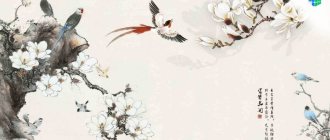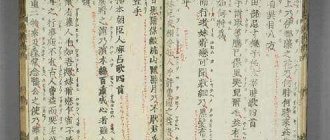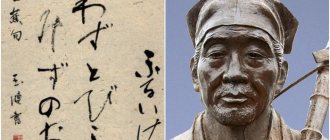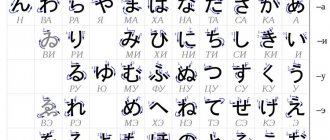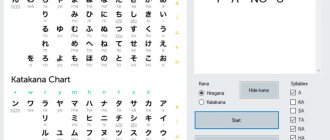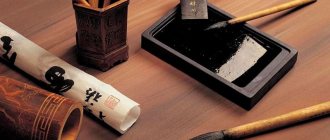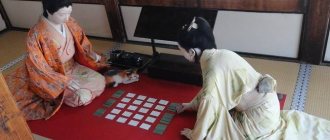Japan is a country with a very unique culture. Its formation was greatly facilitated by the peculiarities of the geographical location and geological factors. The Japanese were able to settle in the valleys and coasts, but they constantly suffer from typhoons, earthquakes, and tsunamis. Therefore, it is not surprising that their national consciousness deifies natural forces, and poetic thought strives to penetrate into the very essence of things. This desire is embodied in laconic forms of art.
Features of Japanese poetry
Before considering examples of haiku, it is necessary to pay attention to the features of the art of the Land of the Rising Sun. This brevity is expressed in different ways. It is also characteristic of the Japanese garden with its empty space, and origami, and works of painting and poetry. The main principles in the art of the Land of the Rising Sun are naturalness, understatement, and minimalism.
In Japanese, words don't rhyme. Therefore, the poetry familiar to the average person in our country could not emerge in this language. However, the Land of the Rising Sun gave the world no less beautiful works called haiku. They contain the wisdom of the eastern people, their unsurpassed ability to understand through natural phenomena the meaning of existence and the essence of man himself.
Japanese tercets: formal elements
As we have already found out, if you write the original Japanese haiku as tercets, then each line will represent one syllabic block of five, seven and five syllables, respectively. In Russian, it is not possible to strictly observe this rule, because the length of words here differs from the length of words in Japanese.
Therefore, it was decided that Russian poetry could differ in structure from the 5-7-5 scheme, but the length of each line should not exceed ten syllables, and one of the lines should be longer than all the others.
You smiled. From a slow ice floe in the distance, a Bird takes off. Andrey Shlyakhov
An important element is kigo - the so-called seasonal words. Their function is to indicate the season or period of time at which the action described in the poem takes place. Such a word either directly names a season of the year, for example, “summer morning,” or denotes an event associated with this season, from which the reader can immediately guess what period of time is depicted in the poem.
The Japanese language has its own kigo, indicating the natural and cultural attractions of Japan, and in our country such words can be, for example, “the first snowdrops” - this is spring, “the first bell” - autumn, the first of September, etc.
Even though there is no rain, On the day of planting bamboo - A raincoat and an umbrella. Matsuo Basho
The second component that characterizes Japanese poetry is kireji, or the so-called cutting word. There are simply no analogues to it in other languages, therefore, when translating poetry into Russian or when writing original Russian tercets, cutting words are replaced with punctuation marks, expressing them using intonation. In addition, all such Japanese tercets can be written with a lowercase letter.
Japanese poems are characterized by the concept of two-partism - dividing the poem into two parts, twelve and five syllables each. In haiku in Russian, you also need to observe two parts: do not write poems in three complete sentences, as well as do not write them in the form of one sentence. Both the first and second parts of the tercet should describe different things, but be interconnected in meaning.
Indian summer... children laugh at the street preacher. Vladislav Vasiliev
Haiku - the poetic art of the Land of the Rising Sun
The careful attitude of the Japanese towards their past, towards the heritage of antiquity, as well as strict adherence to the rules and norms of versification, turned haiku into a genuine art form. In Japan, haiku is a separate type of skill - for example, like the art of calligraphy. It acquired its true capacity at the end of the 17th century. The famous Japanese poet Matsuo Basho managed to raise it to an unsurpassed height.
The person portrayed in the poem is always against the backdrop of nature. Haiku is intended to convey and show phenomena, but not to name them directly. These short poems are sometimes called "pictures of nature" in the art of poetry. It is no coincidence that artistic canvases were also created for haiku.
Size
Many readers wonder how to write haiku. Examples of these poems show: haiku is a short work that consists of only three lines. In this case, the first line should contain five syllables, the second – seven, the third – also five. For centuries, haiku has been the primary poetic form. Brevity, semantic capacity and mandatory appeal to nature are the main characteristics of this genre. In reality, there are many more rules for adding haiku. It’s hard to believe, but in Japan the art of composing such miniatures has been taught for decades. And painting lessons were also added to these activities.
The Japanese also understand haiku as a work consisting of three phrases of 5, 7, 5 syllables. The difference in the perception of these poems by different peoples is that in other languages they are usually written in three lines. In Japanese they are written on one line. And before they could be seen written from top to bottom.
Formal points: number of syllables, kireji, kigo
Number of syllables and lines
The question of the number of syllables in haiku written in Russian and other languages has long been considered resolved. Russian syllables and sound units in Japanese are different things; you can only adhere to the general arrangement of syllables, remembering brevity and conciseness. Write in three lines. Do not exceed the 5-7-5 formula by more than one and a half times, i.e. Use no more than 10 syllables per line. Try to make one of the lines a little longer than the other two. Also, only lowercase letters are allowed.
Seasonal words
After many years of literary discussions and attempts to move away from the canon, modern Japanese poets still agreed to recognize the presence of seasonal words in haiku as mandatory. In their opinion, kigos are necessary because they entail certain associations that significantly expand the semantic and emotional capacity of the poem. In addition, the tradition of using seasonal words formed much earlier than haiku - in tanka poetry - and forms an important part of Japanese artistic culture.
In the Russian literary tradition, such a connection of words to certain seasons is not expressed so clearly. But it is still recommended to include in a haiku a word or phrase that denotes the state of nature at the moment described in the haiku. It's not the seasonal words themselves that are important, but the images they evoke. For example, “plant potatoes” - late spring, “sparklers” - New Year, etc. At the same time, it is important to find precise and concise words that transport the reader to the same situational space of action of the haiku that the author intended.
You smiled. From a slow ice floe in the distance, a Bird takes off. Andrey Shlyakhov
If you want to write about some exceptional natural phenomenon that is unique only to your region, city or village, then write a haibun (a short prose sketch topped with a haiku), otherwise only those living next to you will understand you.
Cutting Word
The dividing word (kireji) has no analogues outside the Japanese language and is replaced by Russian punctuation marks - period, dash, comma, exclamation and question marks, colon, ellipsis - that is, intonationally, since the marks themselves can be omitted by the author.
Two-Part
Haiku should be easy and natural to read. Don't write a haiku in three different sentences - the tercet will look "ragged".
It is also generally not recommended to write haiku in one complete sentence. Divide the haiku into two related parts, separating them with punctuation and semantic breakdown, and saying something different in each part. The further apart the parts are - with internal gravity towards each other - the stronger the current will flow from one pole of the verse to the other. For example:
Indian summer... children laugh at the street preacher Vladislav Vasiliev
What appears before the eye is a picturesque, slightly ironic scene, presented without pressure on the reader’s perception, even with some mystery - the two parts of the verse are quite widely separated. But if you look closely, you can see the connecting threads that make the space between the lines sound: the warmth of Indian summer in the first line and the laughter of children in the third, Indian summer as the last island of the seasonal life of nature and the preacher as a mediator between people and the “truth.” “Be like children” - comes to mind amid the laughter of children... Who comes to people and proclaims about another world, about a better life, etc. at that moment when this world is still so good and enchanting in its last burst of warmth before the autumn cold, the flowering of grass, the celebration of the colors of the leaves that have not yet flown...
Don’t write too much, but don’t cut out what you need either.
In haiku there are a minimum of words. So each one means a lot. When creating haiku, only the most necessary, precise words are selected.
A glance at his wife and the potter starts making a jug again. Bagjo
If you can do without a word in a haiku, try doing without it. Avoid repetitions of words, cognates, meanings - any kind of oil - unless this is a conscious idea.
plans for the new year table littered with papers plans for the new year S. M. Lee
Any work of art is a meeting place between the author and the reader. But for haiku this statement is especially relevant due to the smallness of its volume. What is immediately understandable to a person of one cultural tradition may not be understandable to a person living in another country, with different customs and habits. In haiku, such co-creation is possible only if both of them - the author and the reader - are in a single semantic and cultural field.
In the same way, describing the experience of a person from a different “emotional planet” than the reader can be a game of empty goals. So if you want to write a haiku that other people can understand, first think about how to build a bridge from the image in your mind to the image you want the potential reader to have.
I'm old, new potatoes, green onions Boruko
Show, don't tell!
Paint a picture, showing the bare minimum, but put a little semantic powder in it. Focus on one or two interconnected parts so that you can grab the end of the thread and unwind the entire ball. The reader himself must ask the question “Why?” or “Why?” and find the answer yourself.
Morning dusk. There are long queues near the holes in the fence. Polay First summer rain. I open and... fold the umbrella. Felix Tammy
Write about real, not fictitious events, use simple words
There is no need to speak pompously, pretentiously or use “words” that only you understand. Show everything as it is. But connect the images within the haiku so that they can touch, touch the reader, and make him think. Imagine that you are the director of a movie, and all you have are three moments and images that can be shot without special effects; you also have smells, touches, heat, cold, pain - everything that can be perceived by the senses...
Christmas tree market. Taking off the mitten, the child strokes the needles Svetlana Bobkova
Even at the dawn of the formation of the genre, the creators of haiku called it poetry of sincere feeling and deep thought. In order to change the reader even for a second, to combine in three lines the eternal and the transitory, the natural and the human, the lofty and the ordinary - in order to say a lot through the little, while showing the close interconnection of all things, a haiku must be able to condense a sensation, a memory, a feeling. Such semantic concentration and accuracy can be achieved in several ways.
Don't chew, but don't talk
Important principles of haiku poetry are understatement, ambiguity and after-feeling.
first one, then another, the leaf on the apple tree will tremble Nut Sonya
The author of a haiku does not name the feeling, but evokes it, leading the reader to unfold his chain of associations. The effect caused by haiku is comparable (according to Alexey Andreev) to the effect of an unfinished bridge: you can cross it to the “opposite bank” only by completing it in your imagination. Give up the words “what a melancholy”, “I feel so bad”, “love is gone”, etc.
a little boy looks after the trains... the setting sun Vladislav Vasiliev turns down the radio with his face pressed against the glass a piece of paper outside the window Petrovich_dk a chance meeting - we call our children after each other Taisha and in the biggest house there is no place for plucked water lilies Konstantin Karabcheev
Use the technique of contrast and opposition - objects, plans, phenomena, sensations...
With a furious crash I open the log There is silence inside Andrey Shlyakhov drops on the roofs are transferred to the summer enclosure of hippos Vyacheslav Kanin Stuck in a traffic jam. A white cloud floats slowly by. Yuri Runov The noise of a steam locomotive. The elephants on the chest of drawers are shaking. Alexander Vrublevsky The stars have no number. Me and my dog are wandering along the bottom of the abyss. Kitsune
Compare, compare - objects, plans, phenomena, sensations...
This is one of the most common techniques in haiku. Place related objects and phenomena nearby. Just forget about the words “as”, “as if”, “as if”, “similar” - just find those points in time and space where the coincidence happens on its own.
I admired the fire of autumn leaves. Experienced fireman SKYdancer fog over the river. boys with fishing rods are nodding Sheba late Easter trying all the Easter cakes rain on the Shiroki beach Mirukami in the park tree trunks are whitewashed... the first mini Oleg Tengu full moon. your raincoat is fastened with one button Gleb Secreta, all the paths are covered with snow... the neighbor goes out into the yard with his own path Taisha
Receiving a common line
The second line can be read from both the first and third. This technique creates the volume of the verse, but you should not come up with a special turning line - just to make a “reversal”. Like any technique, the turning line is good where it is appropriate.
full moon between the balcony bars the cat's face Leonid Popov the magazine is closed at the most interesting place change Lena Talaeva the snow falls all night without moving Alexei Grokhotov
Puns, use of homonyms, puns
There is much less homonymy in Russian than in Japanese, but it can also be used.
wine of October, wander under the warm rain, brew... Tengu The ferry departs. The soul is torn in the wind... Goodbye and don't cry. O'Sanchez the wind in the beds grabbed a couple of cabbages on a live thread Alexei Grokhotov early morning... listening to the second wind Konstantin Mikityuk it gets dark in your eyes the first lights are lit Mikhail Baru Christmas rain sat in a puddle snowman Nut Sonya
Allusions, literary and cultural-historical associations
Dream or reality?
The fluttering of a butterfly squeezed in a handful... Yosa Buson “For Buson, this is a tangibly authentic feeling of a butterfly squeezed in a handful, but this particular butterfly can be perceived more broadly - as human life in general, and for a more prepared reader the words “dream” and “butterfly”, placed side by side, will inevitably cause an association with the famous parable of Zhuangzi. Tom once dreamed that he was a butterfly, and when he woke up, he could not understand whether he was Zhuangzi, who dreamed that he was a butterfly, or whether he was a butterfly, which dreamed that she was Zhuangzi. Thus, the meaning of the poem expands more and more - just like a stone thrown into the water leaves behind circles on the water that diverge to the sides.” (T. Sokolova-Delyusina. Japanese poetry. M., 1999).
in the sea I cut my legs on the stones: a mermaid's bay. Natalia Kharag
The fact that the legs were injured not just in some bay, but specifically in the Mermaid, immediately takes a specific event beyond the experience of an individual - one remembers Andersen’s fairy tale... “The Little Mermaid” is read as a cultural-historical reminiscence, that is, it is perceived as a device widespread in classical Japanese poetry. The verse is perceived naturally and easily - precisely because of the elegant allusion.
Unusual in the familiar
Try to show the unusual in a familiar situation. Medieval Japanese haijin have many tercets built on this principle, often accompanied by an exclamation, for example: “and suddenly - wisteria color.”
in the frame the sky is being changed billboard Daria Batalina before the lecture what she will write erases from the board Svetlana Bobkova tiptoes to the bed to wake up the child Svetlana Bobkova Thickly involved On the yellow leaves The first snowman Nora before the parade they shoot the clouds Marina Hagen
Haiku poems: examples for children
Often schoolchildren receive homework assignments to learn or compose haiku. These short poems are easy to read and quick to remember. This is demonstrated by the following example of haiku (2nd grade is too early to cover Japanese poetry, but students can refer to this tercet if necessary):
The sun sets, And the cobwebs also melt in the darkness...
The author of this laconic poem is Basho. Despite the capacity of the tercet, the reader must use his imagination and partially participate in the creative work of the Japanese poet. The following haiku is also written by Basho. In it, the poet depicts the carefree life of a little bird:
In the free meadows the lark bursts into song without labor or worries...
Kigo
Many readers are wondering how to write haiku in Russian. Examples of these tercets show that one of the main features of this genre of poetry is the correlation of a person’s internal state with the time of year. This rule can also be used when composing your own haiku. The rules of classical versification required the use of a special “seasonal” word - kigo. It is a word or phrase that indicates the season described in the poem.
For example, the word "snow" would indicate winter. The phrase “Hazy moon” may indicate the onset of spring. Mention of sakura (Japanese cherry tree) will also indicate spring. The word kinge - “goldfish” - will indicate that the poet depicts summer in his poem. This custom of using kigo came into the haiku genre from other forms. However, these words also help the poet choose laconic words and give the meaning of the work even greater depth.
The following haiku example will tell about summer:
The sun is shining. The birds became quiet at noon. Summer has come.
And after reading the following Japanese tercet, you can understand that the season being described is spring:
Cherry blossoms. Dali was shrouded in fog. Dawn has arrived.
Contents[edit]
When contemplating this picture, the average Japanese is able to add up to 1010101110111010 haiku.
None of them will mention red flowers and blue mountains. 99.9% of haiku is dedicated to this landscape. The remaining billion is dedicated to sakura petals and the reflection of the moon in the water. The content of haiku should combine brevity, grace and philosophical depth. It is considered especially chic to start in health, and end for the repose of devoting the first two lines to one plot, and in the third SUDDENLY
talk about something else, thereby giving an unexpected interpretation and returning the meaning to the beginning.
It’s also good to suddenly stop the train of thought, SUDDENLY
making the reader wonder what the author really wanted to say.
In general, good haiku is always SUDDEN
.
This is the Tao, desu
.
This haiku rule is perfectly illustrated by the great Japanese poet Makukarutenyo-san:
“I’m sad about yesterday, when all sorrows seemed so far from me”
Oh I believe In yesterday SUDDENLY!!
What to write about?[edit]
Yes about everything. The point of haiku is that it is not reality that matters, but your experiences. Which, in turn, must be expressed through some objects of reality.
The less these objects fit your feelings, the better (I remind you once again: good haiku is SUDDEN!
). Since the experiences of the haiku author are always sublime, it is best to express them through all sorts of rubbish. For example, the feeling of love can be expressed through crickets, nostalgia - through a straw broom, and aesthetic pleasure - through the ass through a toad in a pond. These are the laws of the genre.
The exceptions are the moon, sakura and Fuji. Everything can be expressed through them.
In extreme cases, you can not express anything, but simply whine and complain about fate. This is also very much appreciated.
A few selected haiku by famous Japanese poets[edit]
Mikairu Rerumonetobu. “Wandering through the snowy country, I remember the lost capital”
Tell me, uncle-san, is it not for nothing that Moscow, burned by fire, was given to the Frenchman?
Kamikaze Fussiken. “On the seashore I reflect on the immutability of nature”
There is a green oak near the Lukomorye, a golden chain on that oak tree, day and night...
Kamikaze Fussiken. “Sitting with a glass, I lament human futility”
God forbid I go crazy. No! Lighter staff and sumo...
Sasya Buroku. “Sometimes I come home drunk in the dark. Got lost..."
Night, street, lantern, pharmacy. Night, icy ripples of the canal. Pharmacy, street, street lamp...
Sasya Shorune. “I listen to the cry of a child punished with a bamboo stick for getting a D+”
There are cockroaches in the kitchen, leaving the black bread, thinking a little...
Advice
You may have come to this page having already enjoyed the classic masterpieces of Emperor Darth Herohito.
His immortal creations inspire every connoisseur of beauty and even inspire a desire to try to surpass their author, don’t they? Alas! Only Chuck Norris managed to surpass Darth Herohito, and even then only in one discipline, and no one can surpass him in the composition of haiku. So desu nee...
What sadness! There is only one way out - hara-kiri. But you can try to at least get closer to the unattainable ideal. As Bushido says, the goal of the path is not in achieving the goal of the path, but in the process of achieving it.
Iban Turogenyobu. “In days of doubt, in days of painful thoughts, I feel sad about the fate of my homeland.”
How not to fall into despair when you see what is happening at home?
Shiroju Yoshinen. “In a village tavern, a rogue cook served me incorrectly prepared fugu fish.”
I have only one fun left: Fingers in the mouth...
Deviation from the generally accepted norm
There are always artists or poets who strive to break generally accepted, classical rules. The same goes for writing haiku. If the standard for writing these tercets presupposes a 5-7-5 structure, the use of “cutting” and “seasonal” words, then at all times there have been innovators who in their creativity sought to ignore these instructions. There is an opinion that haiku, which do not have a seasonal word, should be classified as senryu - humorous tercets. However, such a categorization does not take into account the existence of flour - haiku, in which there is no indication of the season, and which simply does not need it to reveal its meaning.
How is haiku different from haiku?
You might be confused by the fact that some Japanese poetry is also called haiku, but there is an explanation for this confusion.
Initially, the word “haiku” denoted the first stanza of renga, one of the many genres of ancient Japanese poetry. It could be called a poetic dialogue, or even a polylogue, since it was very often written by two or more poets. Literally, renga means “stringing of stanzas.”
The first stanza of the rengi is written with seventeen syllables in a 5-7-5 pattern - this is haiku. Then comes the second stanza of fourteen syllables - 7-7. The third and fourth stanzas, as well as all subsequent ones, repeat this pattern, that is, the renga scheme looks like 5-7-5-7-7-5-7-5-7-7-…5-7-5-7-7. The number of stanzas is not limited in principle.
If we separate the first and second stanzas from the renga (5-7-5-7-7), we get another popular poetic form in which Japanese poetry is still written - it consists of thirty-one syllables and is called tanka. In translations into European languages, tanka is written in the form of a pentaverse.
Later, haiku became an independent genre, as Japanese poets began to write these poems outside the framework of rengi. And in order to distinguish between independent Japanese tercets and the very first stanza of rengi, in the 21st century the Japanese poet Masaoka Shiki proposed using the term “haiku” for the former. This is exactly what the Japanese themselves now call such tercets.
Haiku without a seasonal word
Let's look at an example of haiku that can be classified in this group:
A cat is walking along a city street, the windows are open.
Here, the indication of what time of year the animal left home is not important - the reader can observe the picture of the cat leaving home, completing the complete picture in his imagination. Perhaps something happened at home that the owners did not pay attention to the open window, and the cat slipped through it and went for a long walk. Maybe the owner of the house is anxiously waiting for her four-legged pet to return. In this haiku example, it is not necessary to indicate the season to describe feelings.
Is there always a hidden meaning in Japanese tercets?
Looking at various examples of haiku, one can see the simplicity of these tercets. Many of them lack hidden meaning. They describe ordinary natural phenomena perceived by the poet. The following example of haiku in Russian, authored by the famous Japanese poet Matsuo Basho, describes a picture of nature:
A raven turns black on a dead branch. Autumn evening.
This is how haiku differs from the Western poetic tradition. Many of them have no hidden meaning, but reflect the true principles of Zen Buddhism. In the West, it is customary to fill every thing with hidden symbolism. This meaning is not found in the following example of nature haiku, also written by Basho:
I'm walking along the path up the mountain. ABOUT! How wonderful! Violet!
Haiku in Japanese[edit]
Haiku (side view)
Composing haiku in Japanese is very Japanese, desu!
Japanese haiku differs from Russian haiku in that they are Japanese.
If you have already mastered the above exercises, it will not be difficult for you to compose real Japanese haiku. Yokatta!
Do everything exactly the same, only use Japanese instead of Russian words.
I hope nihongo-ga dekimas ka?
Examples of haiku in Japanese[edit]
The samurai goes around the country, wanting to dispel the autumn sadness
Osshu-sha crap Hoju tamaishama, hiccup Isshu sake naharyavu
In a foreign land I remember my homeland, contemplating the whirling of falling leaves
Samurai bitches Shirote sake-ne nariri Hoshu domoi
Kakkoi kawaii
[2], isn't it?
General and specific in haiku
It is known that the Japanese people have a cult of nature. In the Land of the Rising Sun, the surrounding world is treated in a completely special way - for its inhabitants, nature is a separate spiritual world. In haiku, the motive of the universal connection of things is manifested. Specific things that are described in tercets are always connected with the general cycle; they become part of a series of endless changes. Even the four seasons of the year are divided by Japanese poets into shorter subseasons.
The first drop from the sky fell on my hand. Autumn is approaching.
Writing Tips
James Hackett, who was one of the most influential Western writers of haiku, believed that these tercets convey sensations “as they are.” And this is precisely what is characteristic of Basho’s poetry, which shows the immediacy of the current moment. Hackett gives the following tips to help you write your own haiku:
- The source of the poem must be life itself. They can and should describe daily events that at first glance seem ordinary.
- When composing haiku, one should contemplate nature in the immediate vicinity.
- It is necessary to identify yourself with what is described in the tercet.
- It is always better to think alone.
- It's better to use simple language.
- It is advisable to mention the time of year.
- Haiku should be simple and clear.
Hackett also said that anyone who wants to create beautiful haiku should remember the words of Basho: “Haiku is the finger that points to the moon.” If this finger is decorated with rings, then the attention of the audience will be focused on these jewelry, and not on the heavenly body. The finger does not need any decoration. In other words, various rhymes, metaphors, similes and other literary devices are unnecessary in haiku.
